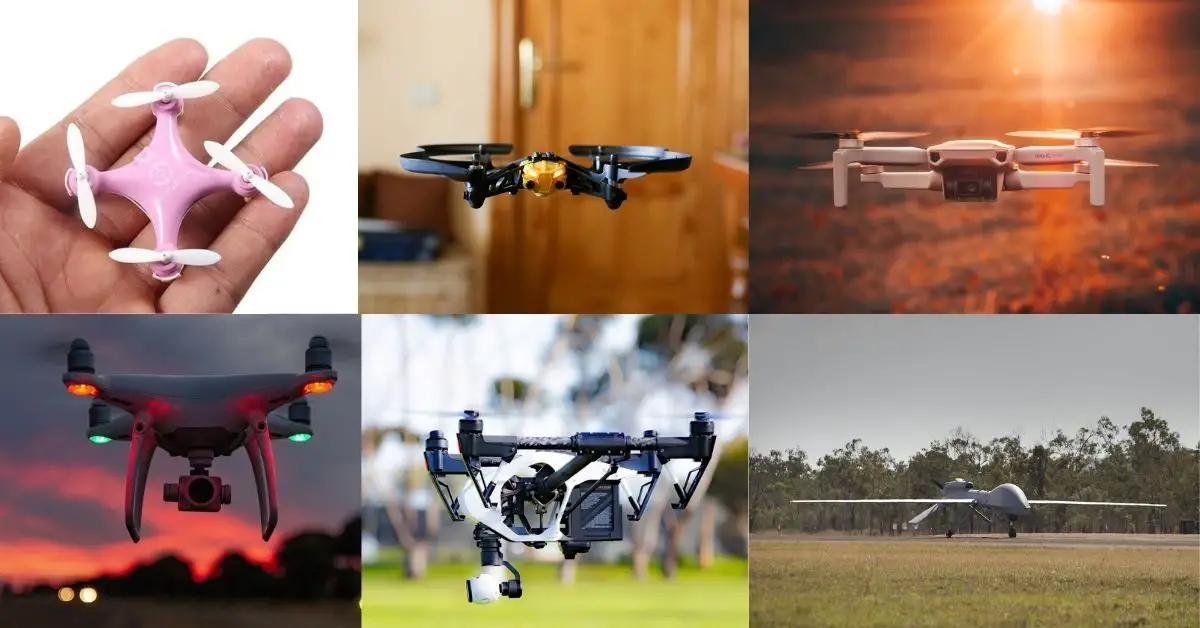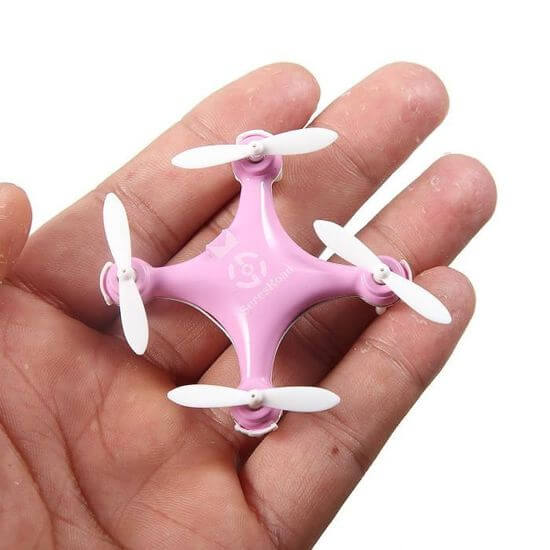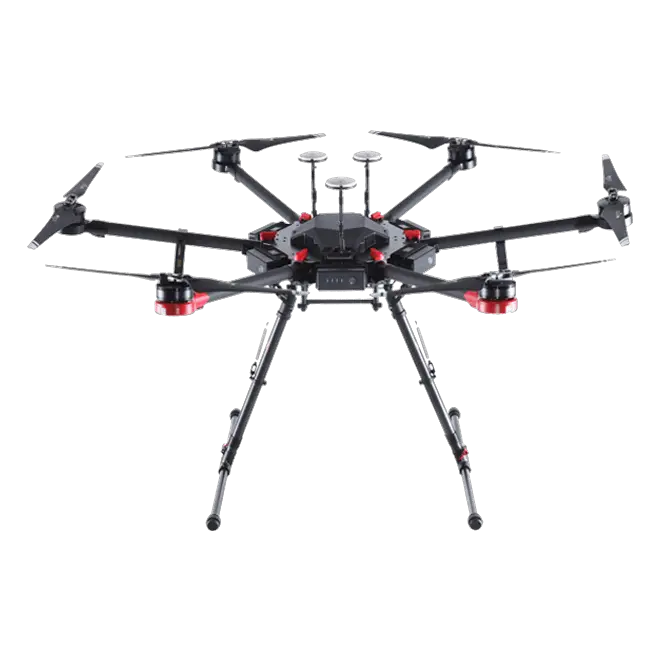Drones come in many shapes, sizes, weights and can each have a unique set of features and capabilities. The size of a drone can impact how easy it is to travel and transport your drone, the features it comes with and how much the drone can carry which affects how many features it comes with.
This post is meant for beginners who want to buy a drone and are curious to discover the different sizes drones can come in, and for those who plan on building their own drones.
It’s also meant for those who are fascinated with this awesome technology and who want to learn the different sizes of consumer, commercial and military drones.
So, what are the sizes of drones?
Consumer and commercial drones go from very small drones weighing only 200g (0.2kg or 0.44 lbs) or less and being 150mm (15cm or 6 inches) in length or less, to large drones weighing 20kg (44 lbs) and up and being 120cm (1200mm or about 4ft) and up in length. Military drones go from small drones weighing less than 150kg (<331 lbs) and are known as nano, mini or small military drones to large drones weighing over 600kg (>1323 lbs).
Does The Size Of A Drone Matter?
Before we get right into the different sizes drones can come in, it’s important to determine whether or not the size of a drone actually matters.
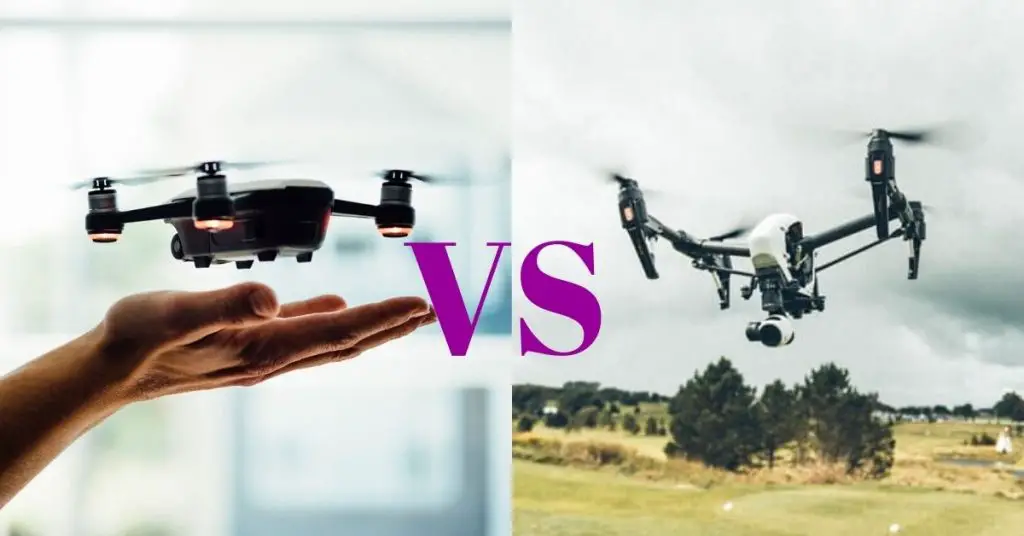
Whether it matters or not will be up to you and will be determined according to your situation and your needs.
If you’re someone who likes to travel a lot, then you may prefer a drone that is small and lightweight. These drones are often cheaper than bigger drones but have lighter payloads.
If you’re someone who plans on buying a drone for your photography business, then you may just want the drone to have the optimum features and higher payloads in order to fit a high-quality camera and a 3-axis drone gimbal.
The gimbal keeps the camera steady as the drone moves around.
If you’d like to find out what a drone gimbal is, what kinds of drone gimbals are available, whether drones need gimbals, how a drone gimbal works, how to choose the right gimbal, how much they cost and much more, check out our post on this topic below:
Related Post: What Is A Drone Gimbal? Does Your Drone Need One? [Types, How They Work, Prices And How To Choose One]
Size and weight can be an important factor that plays a deciding role in whether you buy the drone or not.
The larger the drone, the less agility it has in the air. This means bigger drones will be less maneuverable. If you’re trying to race your drone, then a large drone is not for you.
Large drones are also typically more stable than small drones. This can be beneficial for those using their drones for photography.
They are also typically stronger and more durable, but this will more often depend on the price of the product.
To summarise, the differences between small and large drones are the level of practicality, the available features, the price and more often than not the quality of the product.
You may need to register your drone
In most countries, the size of a drone plays the primary factor that determines whether you need to register the drone.
In the United States, the Federal Aviation Administration (FAA) have put a rule in place where you must register your drone if it weighs more than 250 grams (0.55 pounds) and less than 25 kg (55 pounds). This refers to the takeoff weight of the aircraft with all the accessories included.
Drones that weigh more than 25 kg (55 pounds) are considered traditional aircraft and will require a different process to register them.
This rule only applies if you are flying under the Exception for Recreational Flyers rule (meaning you’re a drone hobbyist). This was put in place to ensure the safety of national airspace.
If you’d like to learn how to register your drone, then check out the FAA’s official website where they walk you through it here.
If you don’t register your drone when you should have, you could get into serious trouble. We outline the legal trouble you could run into in this article below:
Related Post: This Is What Happens If You Fail To Register Your Drone In The US
It’s important to note that the Recreational UAS Safety Test or TRUST is soon going to come out and is in it’s final state of preparation as of June 2021. Recreational flyers will soon be required to pass TRUST and be able to show proof of having passed the test when flying.
You may need remote ID
A requirement put in place by the FAA has also stated that on September 16 2023, it will be a requirement for all drone owners that are required to register their drones to have remote ID. This was put in place to further improve the security of national airspace.
According to the FAA:
A Standard Remote ID Drone or a drone with a remote ID broadcast module must transmit the following message elements:
-A unique identifier for the drone;
-The drone’s latitude, longitude, geometric altitude, and velocity;
-An indication of the latitude, longitude, geometric altitude of its control station (standard) or take-off location (broadcast module);
-A time mark; and
-Emergency status (Standard Remote ID Drone only)
Source
To learn more about remote ID, we urge you to check out the official page on the FAA’s website about this topic here.
Consumer And Commercial Drone Sizes
You’ll often find that the size of the drone may influence it’s quality and price. For example, very large drones may cost a tremendous amount of money whereas tiny drones may only cost you a few dollars.
Below we will talk about the sizes of hobby/recreational drones and commercial/professional drones. We’ll mention the typical prop sizes, lengths and weights of these different sized drones.
We’ve broken the list up into very small drones, small drones, medium-size drones and large drones.
Very small consumer and commercial drones
Very small consumer and commercial drones are typically referred to as ‘Nano’ drones. These drones are often smaller than the palm of your hand.
Here is a small table which gives the range of weight, length and propeller diameters of nano drones:
| Weight | Length | Propeller Diameter |
| 200 grams (0.2kg, 0.44lbs) or less | 150mm (15cm, 6 inches) or less | 51mm (2 inches) or less |
One of the world’s smallest drones is the Cheerson CX-10 Mini which has a length of 41mm (1.6 inches) and has a weight of 12 grams (0.4 ounces or 0.026 lbs).
Small consumer and commercial drones
Small drones are typically referred to as ‘Mini’ drones. These drones are often a little larger than the size of the palm of your hand, but can still comfortably sit in your palm.
Here is a small table which gives the range of weight, length and propeller diameters of mini drones:
| Weight | Length | Propeller Diameter |
| 200-1000 grams (0.44-2.2lbs) | Up to 300mm (12 inches) | 76-152mm (3-6 inches) |
One popular example of a mini drone is the DJI Mini 2 which weighs less than 249 grams (<0.55 lbs), has a length of 159mm (0.63 inches) and a propeller diameter of 119 mm (4.7 inches).
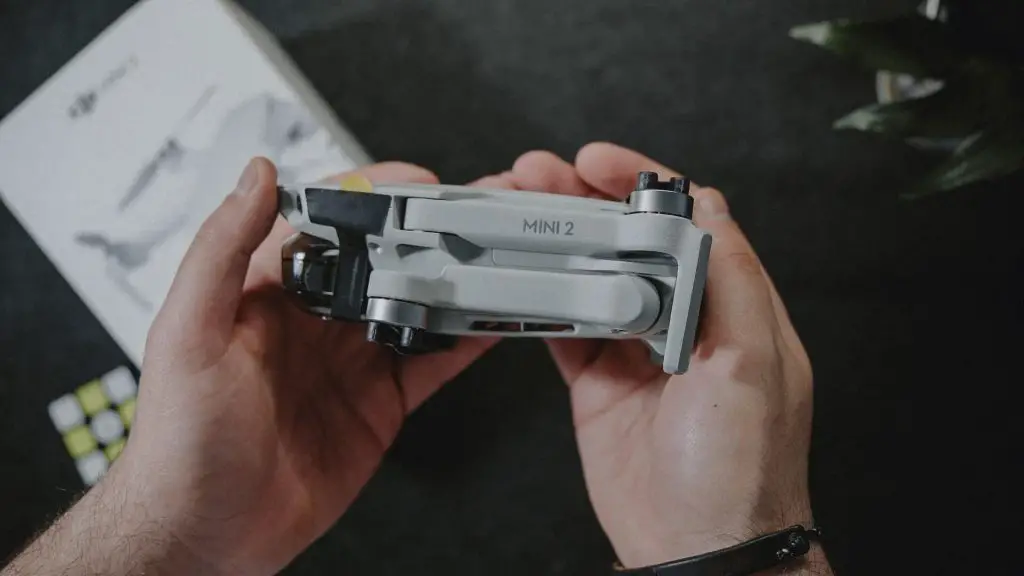
Medium-size consumer and commercial drones
Medium-size drones are often the most popular drones used for things such as photography. These drones are beginning to be in the heavier range and may require two hands to carry around.
Here is a small table which gives the range of weight, length and propeller diameters of medium-size drones:
| Weight | Length | Propeller Diameter |
| 1-20kg (2.2-44 pounds) | 300-1200mm (12 inches – 4 feet) | 150-640 mm (6-25 inches) |
An example of a popular medium-size drone is the Matrice 600 Pro. This drone has a maximum takeoff weight of 15.5kg (34 pounds), a length of 113cm (1133mm), and a propeller diameter of 53cm (21 inches).
Large consumer and commercial drones
Large drones are more often used for professional applications. They are no longer capable of being carried around by one person.
Here is a small table which gives the range of weight, length and propeller diameters of large drones:
| Weight | Length | Propeller Diameter |
| 20kg (44 pounds) and up | 120cm (4 feet) and up | 64 cm (25 inches) and up |
An example of a large drone would be the cargo drone by Boeing called the Cargo Air Vehicle (CAV). This drone is still in the experimental stage but is currently one of the largest commercial drones in the world. This drone weighs 498.95 kilograms (1,100 pounds) and has a length of 17.5 feet long (533cm).
Military Drone Sizes
Below we discuss the sizes of military unmanned aerial vehicles (UAV). We’ll mention the typical prop sizes, lengths and weights of these different sized drones.
We’ve broken the list up into small drones, medium-size drones and large drones.
Military UAV can be classified in three weight classes:
- Class I (<150kg or 330 lbs)
- Class II (150-600kg or 330-1,320 lbs)
- Class III (>600kg or 1,320 lbs)
It’s important to note that a large majority of military drones are fixed-wing drones as these are more efficient and faster than multi-rotor drones.
If you’d like to learn more on the different types of drones including the types according to design, payload, range, power source and use cases including some examples of both consumer, commercial and military drones, then check out our full post below:
Related Post: What Types Of Drones Are There? Every Type Of Drone Explained In Detail
Small military drones
Small drones fall under the class I (<150kg or 330 lbs) category. These are typically the military nano, mini and small drones in general. These drones are often launched with one arm by a human or launched via a catapult system.
They can be used to provide ISTAR (Intelligence, Surveillance, Target Acquisition and Reconnaissance).
An example of a class I military unmanned aerial system (UAS) is the Fulmar X fixed-wing drone. This drone is 120cm (4 feet) long, it has a wingspan of 300cm (10 feet) and has a maximum takeoff weight of up to 20kg (44 pounds). This drone can reach speeds of up to 100 km/h (62 mph), with an operating range of up to 800km (500 miles).
Here is a short video showing the Fulmar X in action, including the takeoff catapult system and the recovery net retrieval system.
Medium-size military drones
Medium-size drones fall under the class II (150-600 kg or 330-1,320 lbs) tactical category. These drones are often used for medium-range surveillance.
These drones fit in between the mini UAVs and strategic class III UAVs which all consist of Medium Altitude Long Endurance (MALE) or High Altitude Long Endurance (HALE) drones.
They offer protection, situational awareness and target acquisition in and out of battle serving as an essential tool for the military.
An example of a medium-size class II tactical military UAV is the RQ-7B Shadow V2 fixed-wing drone. This drone is 360 cm (12 feet) long, it has a wingspan of 600 cm (20 feet) and has a maximum takeoff weight of up to 212kg (467 pounds). This drone can reach speeds of up to 200 km/h (124 mph), with an operating range of up to 125km (78 miles).
Here is a short video showing the RQ-7B Shadow V2 in action:
Large military drones
Large military drones fall under the class III (>600kg or 1,320 lbs) strategic category. These drones are similar in size to small aircraft and are replacing fighter jets for things such as surveillance and strategy.
They are also referred to as Medium Altitude Long Endurance (MALE) and High Altitude Long Endurance (HALE) UAVs. They have state of the art technology allowing for fast enemy detection and combat capabilities.
The MALEs are especially ideal for surveillance as well as reconnaissance on a non-threatening area.
An example of a large military UAV would be the MQ-1C Gray Eagle MALE fixed-wing UAV. This drone is 900 cm (29.5 feet) long, it has a wingspan of 1700 cm (55.8 feet) and has a maximum takeoff weight of up to 1633kg (3600 pounds). This drone can reach speeds of up to 278 km/h (173 mph), with an operating range of up to 400km (249 miles).
Here is a short video showing the MQ-1C in action:
How Do You Measure The Frame Size Of A Drone?
Below we’ll explain how to measure the ‘wheelbase’ or ‘diagonal length’ of a drone. This can work with any multi-rotor drone.
On multi-rotor drones, it’s actually quite simple. All you need to do is measure the distance between two opposite corner motors of the drone that are diagonal to each other.
Here is an image showing the process.
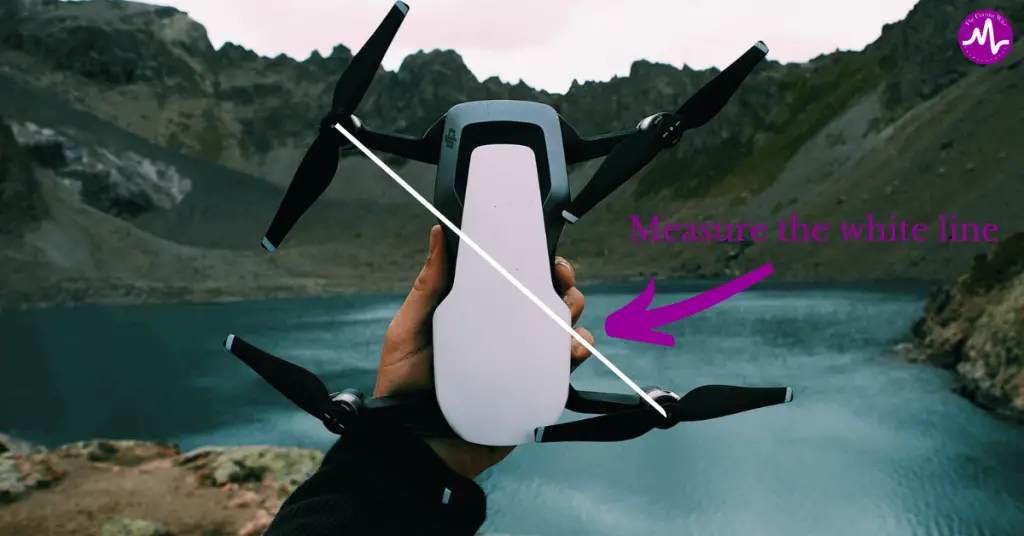
That’s pretty much all there is to it. Just make sure you measure in millimeters.
Take note that most drone manufacturers round these measurements up. The size you see being stated on the specifications table of that drone may be a few millimeters off.
Drone Size Comparison (Examples Of Popular Drones)
Below is a table showing several popular drones of each type and size for consumer, commercial and military drones.
Here is a table showing a list of very small to large popular consumer and commercial drones:
| Drone Model | Size Category | Weight | Length |
| Hubsan H111 NANO Q4 | Very Small | 11.5g | 38mm |
| SYMA X12S NANO | Very Small | 28g | 77mm |
| DJI Mavic Air 2 | Small | 570g | 183mm (Unfolded) |
| Parrot Anafi | Small | 320g | 175mm (Unfolded) |
| DJI Phantom 4 Pro V2.0 | Medium-Size | 1375g | 289.5mm |
| DJI Inspire 2 | Medium-Size | 4250g | 427mm |
| Yuneec H520 | Large | 1995g | 520mm |
| Autel Robotics Dragonfish | Large (Fixed-Wing) | 7.5kg | 230cm |
Here is a table showing a list of small to large popular military unmanned aerial aircraft (UAV):
| Drone Model | Size Category | Weight | Length | Wingspan |
| FLIR Black Hornet 3 | Small (Single-Rotor) | 1.3kg | 20cm | Width=12cm |
| AeroVironment Wasp III | Small | 1.3kg | 39cm | 72.3cm |
| BAE Systems Herti | Medium-Size | 650kg | 5m | 12m |
| Thales Group Watchkeeper WK450 | Medium-Size | 450kg | 6.5m | 10.9m |
| General Atomics MQ-9 Reaper | Large | 4,760kg | 11m | 20m |
| Northrop Grumman RQ-4 Global Hawk | Large | 14,628kg | 14.5m | 40m |
Drone Size By Use Case
If you plan on buying or making a drone for a specific application, then you’ll need to size it appropriately in order for it to be capable of accomplishing the task you want it to do.
Below we will mention three use cases for drones which dive into the leisure and commercial uses of drones.
Average size and weight of a racing drone
Racing drones usually measure around 250mm and weigh between 454-907 grams (0.45-0.91kg or 1-2 lbs). A racing drone needs to be lightweight, maneuverable and aerodynamic if the drone pilot plans on attaining high speeds.
These drones carry the essentials needed such as a small battery that is commonly attached to the outside of the frame, the flight controller, motors, propellers, electronic speed controller, power distribution board, camera, transmitter and receiver.
If you’d like to learn more on what a drone is made of including definitions of all the components we mentioned above and the materials drones are commonly made of then check out our full post below:
Related Post: What Are Drones Made Of? Detailed Guide To Drone Anatomy [Consumer+Commercial]
Average size and weight of a photography drone
Photography drones usually measure between 180-400 mm (7-16 inches) and weigh between 570-3,000g (1.2-6.6 lbs). A photography drone needs to smoothly balance the amount of features it has with the stability and balance capabilities it offers. This ensures that professional quality footage is captured.
If you purchase a drone or purchase equipment from reputable drone manufacturers than you can be sure to obtain the highest quality product for the product’s price range.
If you’d like to discover what some of the best drone companies are in the world and some fun facts about them, we have a full post on this topic below:
Related Post: Top Drone Companies/Manufacturers In The World [History, What They Offer, Popular Drones And More]
Average size and weight of an agricultural drone
Agricultural drones measure between 520-2000 mm (20 inches – 6.5 feet) and weigh between 1-20kg (2.2-44 lbs). These measurements depend on the quality and price of the product, including the amount of features the drone offers. If the drone is more efficient with longer flight times, more resistance to things such as temperature and wind, and has a larger spray tank volume, then it may weigh more and come larger.
Conclusion
Drones are continuing to improve in efficiency while still remaining as effective as possible. Manufacturers are finding new and innovative ways to improve upon this technology.
In a few years, these size categories may change due to this evolving technology.
We hope you enjoyed this post and discovered something new on the various sizes consumer, commercial and military drones can come in.
